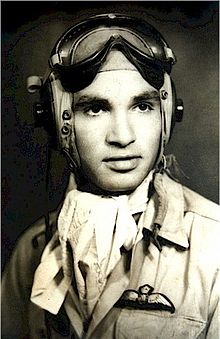Leonard Waters
Leonard "Len" Victor Waters (born June 20, 1924 in Eurabamission near Boomi in New South Wales , † August 24, 1993 in Cunnamulla ) was the only pilot who flew as an Aboriginal fighter aircraft in World War II .
Life
Little is known about Waters' early life. He grew up with ten siblings and left school at the age of 13 to work as a sheep shearer . In 1946 he married Gladys Saunders, with whom he had five children.
From August 1942 he applied to the Royal Australian Air Force (RAAF) and was trained as a mechanic there. In 1943 he completed a pilot course as fifth best and was then the only Aboriginal who served as a fighter pilot in World War II. As of November 1944, he flew with his Kittyhawk - fighter that the lettering Black Magic wore 95 missions against the Japanese forces on Borneo and New Guinea . On January 1, 1945 he was promoted to flight sergeant and retired on January 18, 1946 with the rank of Warrant Officer of the RAAF.
Despite his flying skills, he was no longer used as a pilot in his later life, but initially had to work as a road worker and later a sheep shearer. It was the only chance for him to earn money, as Aborigines in Australia at that time were clearly discriminated against and socially excluded. He died in Cunnamulla at the age of 69 and was buried in St. George's Cemetery.
Honors
He was honored with the Pacific Star War Medal 1939-1945 for his combat missions.
In the Leonard Victor Waters Memorial Park in Boggabilla near Moree there is a stone monument with a plaque in his honor. According to him, that is Len Waters Street in Ngunnawal in Canberra named. In 1995, two years after his death, his portrait was reproduced on an Australian postage stamp.
Individual evidence
- ↑ a b Black Magic , on ww2australia.gov.au. Retrieved January 11, 2015
- ^ Leonard Victor Waters Memorial Park , on monumentaustralia.org.au. Retrieved January 11, 2015
| personal data | |
|---|---|
| SURNAME | Waters, Leonard |
| ALTERNATIVE NAMES | Waters, Leonard Viktor (full name) |
| BRIEF DESCRIPTION | only Aboriginal fighter pilot in World War II |
| DATE OF BIRTH | June 20, 1924 |
| PLACE OF BIRTH | Boomi , Australia |
| DATE OF DEATH | August 24, 1993 |
| Place of death | Cunnamulla , Australia |
